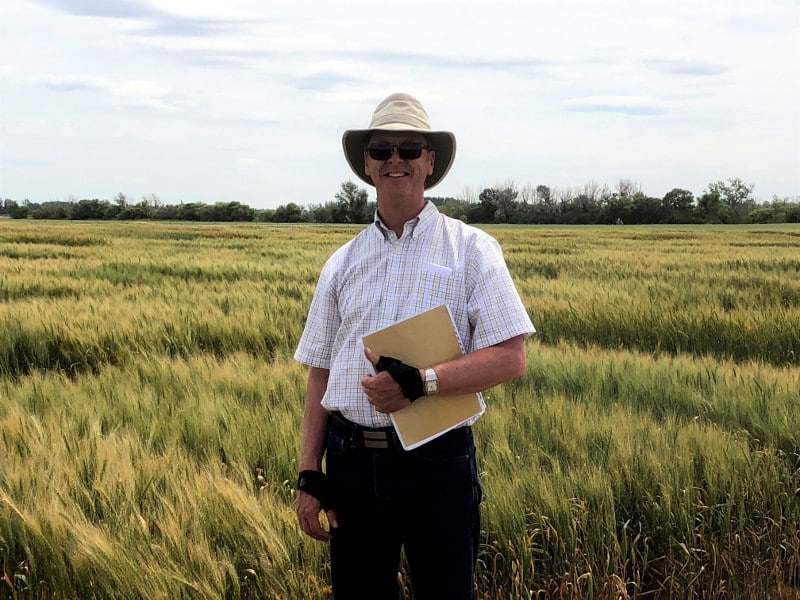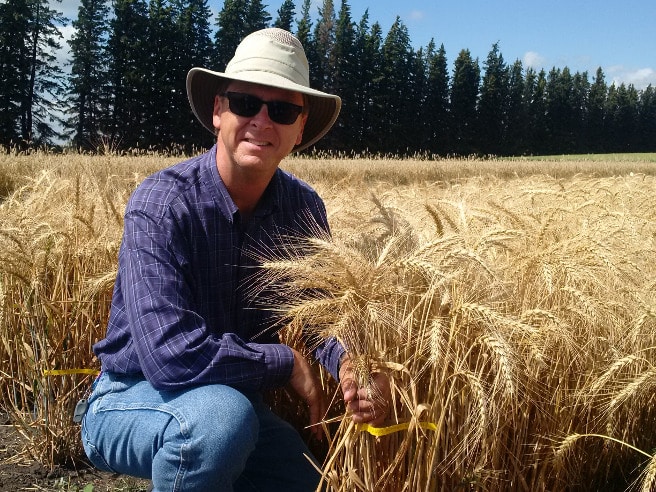Rob Graf had many “mountaintop moments” during his career, but the defining one would arguably be his status as one of Canada’s top winter wheat breeders.
AC Emerson was the first variety of any wheat class in Canada to get a Resistant rating to FHB. AAC Wildfire, registered in 2015, and AAC Coldfront, which recently received registration, represent new yield levels for winter wheat on the Prairies.
In 2021, Graf’s varieties represented over 85 per cent of the planted acres for milling quality winter wheat in Western Canada.
Graf is a truly contemporary breeder, taking into consideration both the interests of farmers and the interests of end users, who are looking for winter wheat that has better flour water absorption.
In 2019, he won the Canadian Plant Breeding & Genetics Award, sponsored by Germination and Seeds Canada, given to Canada’s top plant breeders.
He recently retired after 35 years breeding some of Canada’s best-known winter wheat varieties, 23 of those years spent at Agriculture and Agri-Food Canada in Lethbridge, Alta. We caught up with him to ask about some of his favourite career moments and what he sees the future holding for winter wheat in Canada.
Why did you choose winter wheat to focus your career on?
Back when I bred spring wheat, I very much regarded winter wheat as a niche crop that was mostly grown in southern Alberta. As a spring wheat breeder, originally when I was asked to collaborate and put in a winter wheat trial all those years ago, it was just kind of a nuisance. I had to have standing stubble and plan for it, which I didn’t have to do with spring wheat. But once I started working on winter wheat, it didn’t take very long to understand all the benefits of the crop, and the tremendous breeding potential for Western Canada.
What made you want to retire at this point?
My wife Linda and I have always had the attitude that we know we’ve got limited time on this earth, and at some point we need to retire and pass the torch on to the next generation. I’m really happy and satisfied with the breeding progress I’ve been able to accomplish over the years, of course with the financial help and advocacy of farmers, producer commissions, and Ducks Unlimited Canada. Everyone involved is really part of the success story.
What guided you in your winter wheat breeding journey?
When I started breeding winter wheat in 1999, there had certainly been progress in developing improved varieties for Western Canada, but from an industry perspective, it certainly wasn’t as great as what had been accomplished in spring wheat. What I very rapidly discovered was that
there were still many improvements that needed to be made. In my mind, it was pretty clear where we needed to go.

Where was that?
A lot of work had already been done on improving plant type and yield, with shorter stature varieties of better lodging resistance available to farmers. An obvious area for improvement was disease resistance. For example, AC Bellatrix had just been registered. It was a good milling quality winter wheat with bunt resistance, but that’s the only type of disease resistance it had. There were also couple of other varieties that had leaf and/or stem rust resistance but were of poorer quality which were eventually removed from the Canada Western Red Winter (CWRW) class. It became pretty clear to me that we needed to develop good milling quality varieties that combined many types of disease resistance, including fusarium head blight and stripe rust resistance, objectives that were added in the mid-2000s. From the quality side, the classes are pretty well defined. When I started, Canada Western Red Winter was the only winter wheat class, and in order to get be registered, lines had to have certain milling, baking and dough functionality attributes. Starting in 2008, the Special Purpose class created the possibility of developing varieties for alternative markets in both spring and winter wheat, though to date these varieties have had limited uptake.
What did that process look like?
The primary objective was to develop agronomically superior CWRW varieties with resistance to all three rusts and then add resistance to FHB, bunt, wheat curl mite, and so on. We’ve accomplished that, but the challenge is now to pyramid several effective genes for each disease into new varieties so achieve long-lasting, durable resistance. That’s really the next phase and is well underway. In order to do that, we can use marker assisted selection, where we use molecular markers to track the genes that we incorporate.
What’s one of your top pieces of advice for how we can maintain a strong plant breeding industry in Canada?
I’m a very staunch supporter of a strong variety registration system, because it evaluates the merit of new varieties relative to industry standards. I see that as absolutely critical not just for our producers, but for the entire industry. I don’t know any farmers that say they want more varieties. What they do want is better varieties, and an effective registration system is central to that. Over the past decade, the evolution of the Prairie Grain Development Committee, where there is now very good predictability, transparency and cross-sectorial representation, has been very important.
What’s the top challenge breeders face in the future in your opinion?
We’ve been seeing a lot more variability in our climate over the past decade. Breeders will continue to have to develop varieties that are going to work well in all these different environments while resisting constantly evolving disease and insect threats. It probably means that it’s not just one or two varieties that are going to carry the day. What are the implications of that? We’re going to need larger plant breeding programs to find those rare segregants that work well in particular environments. We also need to have effective post-registration testing systems so that we get a good handle on where new varieties are regionally adapted so farmers can make informed choices as to what they should grow. Ultimately, all of this will take more funding. How do we get more investment in breeding? There are different ideas. Now that we’ve turned the corner on the pandemic, we need to restart some of these conversations. I think these are exciting times and I hope to be able to contribute.
—with files from Trevor Bacque












